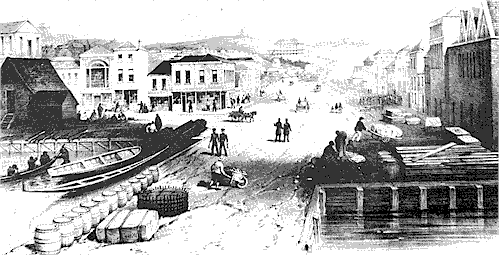EARLY YEARS AT PAKURANGA PAGE 1 0F 3
Early Years of the Young Qualtroughs from the book "A Quota of Qualtrough" 41-47
IT WAS spring in New Zealand when the jaunty Mermaid swept into Auckland waters well ahead of her illustrious rival, the Maori, on 19 October, 1859.
Triple-coned Rangitoto, awesome guardian of the Waitemata, a volcanic peak merely dormant, dominated the other half-dozen of inshore islands.
"Waitemata? It means 'sparkling waters'."
The translation rippled through the ship as excitement mounted. The end of the voyage!

Looking South from Queen Street (Auckland) Wharf in the 1850s. A similar scene must have greeted the QUALTROUGHs on their arrival in 1859. In the foreground is the Queen Street and Shortland Street intersection. Partington's Mill is in the background.
Old gravures show Auckland of those days with wooden jetties on a shoreline no longer in existence, high up in what is now a multi-story Downtown of Auckland City. There were buildings -the first warehouses and business offices, hotels, private guest-houses, a few shops and silhouetted on the skyline, Partington's Mill. Here and there, a horse-team drawn cart, a bullock wagon, a saddled horse, await further orders and pedestrians moved grace-fully on cobbled streets. The men, in narrow-legged trousers, longish jackets and high hats, escorted ladies in full skirts, bonnets and often with parasols. Pictures which included Maoris showed them in European clothing with tattooed faces, many of them bewhiskered, some with long greenstone ear pendants, somewhat incongruous in their satirical anachronisms.
Grafton Gully - no bridge as yet - had masses of feathery tree ferns, tall kahakiteas and puriris, topped by an occasional kauri in silhouette, highlighted by a stand of golden kowhai in bloom.
There was much open space among the stolid brown buildings, land that sloped away to open country which rolled towards green hills and blue skies on a long horizon.
Auckland in October, warmth in the sun and a brisk sea breeze scudding clouds that held suggestions of a passing shower across the slender neck of land separating the Waitemata from the Manukau. On the waterfront investigating seabirds, keen and exultant in their discoveries, must have touched chords of memory for the immigrants whose home shores were far away.
James had been allotted Crown land out from Papakura, about 45 kilometers southward from Auckland, in the Hunua bush. Exactly where we haven't been able to ascertain. It comprised approximately120 hectares on the arithmetic of the 40-Acre Scheme.
After the preliminaries and formalities of landing and the business at the Land Office, the Qualtroughs were introduced to a bush settler-farmer who lived about two kilometers away from their allotment. He was to take them by bullock cart to their land and give them a hand settling in. James paid him £1 (sterling) a day, which he did not consider excessive in view of the work and time involved; and no doubt for the useful information he could impart.
Papakura was on the Great South Road, which had evolved from the portage tracks of the Maoris to a highway metalled as far as Drury. There was actually a daily coach service from Auckland to Drury, run by a Mr. William Young. It was known, grandly, as the "Auckland, Papakura and Drury Diligence."
It would not have accommodated the Qualtroughs and their possessions, though, for according to THE NEW ZEALANDER, issue dated 23 December 1857, it was capable of carrying …. "nine substantial yeoman or traders and even nine ladies (provided their several courses of vestments were not open to Mr Punch's rebuke) with comfort and without distress to their horses." The PUNCH reference was to a topical joke taken from the famous magazine which was eagerly-awaited reading from 'Home'.
© 2021 by Malcolm Qualtrough, Elizabeth Feisst and the late John Karran Qualtrough.
Hosted by Ask Web Design, Isle of Man.